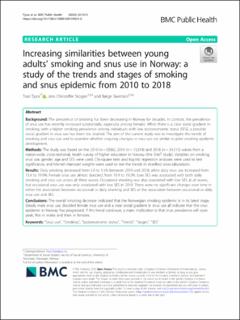| dc.contributor.author | Tjora, Tore | |
| dc.contributor.author | Skogen, Jens Christoffer | |
| dc.contributor.author | Sivertsen, Børge | |
| dc.date.accessioned | 2020-10-13T10:56:39Z | |
| dc.date.available | 2020-10-13T10:56:39Z | |
| dc.date.created | 2020-10-07T20:06:19Z | |
| dc.date.issued | 2020-10 | |
| dc.identifier.citation | Tjora, T., Skogen, J.C., Sivertsen, B. (2020) Increasing similarities between young adults' smoking and snus use in Norway: a study of the trends and stages of smoking and snus epidemic from 2010 to 2018. BMC Public Health, 20. | en_US |
| dc.identifier.issn | 1471-2458 | |
| dc.identifier.uri | https://hdl.handle.net/11250/2682441 | |
| dc.description.abstract | Background
The prevalence of smoking has been decreasing in Norway for decades. In contrast, the prevalence of snus use has recently increased substantially, especially among females. While there is a clear social gradient in smoking, with a higher smoking prevalence among individuals with low socioeconomic status (SES), a possible social gradient in snus use has been less studied. The aim of the current study was to investigate the trends of smoking and snus use and to examine whether ongoing changes in snus use are similar to prior smoking epidemic development.
Methods
The study was based on the 2010 (n = 5836), 2014 (n = 13,319) and 2018 (n = 24,515) waves from a nation-wide, cross-sectional, health survey of higher education in Norway (the SHoT study). Variables on smoking, snus use, gender, age and SES were used. Chi-square tests and logistic regression analyses were used to test significance, and Mantel–Haenszel weights were used to test the trends in stratified cross-tabulations.
Results
Daily smoking decreased from 5.9 to 1.5% between 2010 and 2018, while daily snus use increased from 13.4 to 19.9%. Female snus use almost doubled, from 10.9 to 19.2%. Low SES was associated with both daily smoking and snus use across all three waves. Occasional smoking was also associated with low SES at all waves, but occasional snus use was only associated with low SES in 2010. There were no significant changes over time in either the association between occasional or daily smoking and SES or the association between occasional or daily snus use and SES.
Conclusions
The overall smoking decrease indicated that the Norwegian smoking epidemic is in its latest stage. Steady male snus use, doubled female snus use and a clear social gradient in snus use all indicate that the snus epidemic in Norway has progressed. If this trend continues, a main implication is that snus prevalence will soon peak, first in males and then in females. | en_US |
| dc.language.iso | eng | en_US |
| dc.publisher | BioMed Central | en_US |
| dc.rights | Navngivelse 4.0 Internasjonal | * |
| dc.rights.uri | http://creativecommons.org/licenses/by/4.0/deed.no | * |
| dc.subject | snus | en_US |
| dc.subject | røyk | en_US |
| dc.subject | tobakk | en_US |
| dc.subject | folkehelse | en_US |
| dc.title | Increasing similarities between young adults' smoking and snus use in Norway: a study of the trends and stages of smoking and snus epidemic from 2010 to 2018 | en_US |
| dc.type | Peer reviewed | en_US |
| dc.type | Journal article | en_US |
| dc.description.version | publishedVersion | en_US |
| dc.rights.holder | © The Author(s). 2020 | en_US |
| dc.subject.nsi | VDP::Medisinske Fag: 700::Helsefag: 800::Samfunnsmedisin, sosialmedisin: 801 | en_US |
| dc.source.pagenumber | 8 | en_US |
| dc.source.volume | 20 | en_US |
| dc.source.journal | BMC Public Health | en_US |
| dc.identifier.doi | 10.1186/s12889-020-09604-6 | |
| dc.identifier.cristin | 1838045 | |
| cristin.ispublished | true | |
| cristin.fulltext | original | |
| cristin.qualitycode | 1 | |

